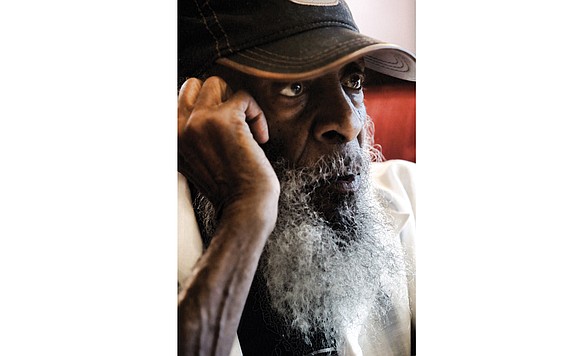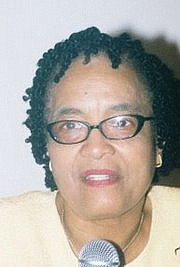Dick Gregory: What is seen and unseen
9/29/2017, 7:27 a.m.
By Barbara Reynolds
The celebration of the life of Dick Gregory on Sept. 16 at the City of Praise Family Ministries in Landover, Md., was more than seven hours of eclectic diversity, from a serenade by Native Americans to a musical tribute by Ayanna Gregory, Mr. Gregory’s daughter, and Stevie Wonder, to speakers MSNBC’s Lawrence O’ Donnell and Washington Mayor Muriel Bowser, to the fiery Rep. Maxine Waters, who vowed to help impeach that “thing” in the White House.
There were torrents of “hallelujah” and especially “as-salaam alaikum” as Nation of Islam head Minister Louis Farrakhan began a profoundly uplifting eulogy.
It was fascinating to see how a man born so far down in the cracks of society could rise so far: Jailed countless times in the fight for human rights; 13 books written; a star on Hollywood’s Walk of Fame, movie roles, a celebrated humorist and global humanitarian. Mr. Gregory was born in 1932 in the slums of St. Louis. His mother, Lucille Gregory, had to put plastic on her feet to keep them from getting wet as she walked to work. When Mr. Gregory was 10, a white man knocked out two of his front teeth for touching a white woman as he shined her shoes. The family was chronically evicted for the inability to pay their $18 monthly rent.
What kind of journalist would I have become if it had not been for Mr. Gregory becoming my mentor and coach for more than three decades as I tried to survive as a pioneering black woman journalist in white newsrooms? He was the one who pushed me to go out on a limb for unpopular people and for causes even if the limb broke off; how not to discount conspiracies just because it is safer to believe a lie rather than an unpopular truth; and how to expose the liars and the exploiters in high places, no matter who and where they were.
Should I state the obvious of how badly Mr. Gregory is still needed today?
Of course, following the Dick Gregory stylebook meant you wouldn’t have a job long. In some newsrooms, the reward for not toeing the company line, disbelieving that white is always right, and caring more for the masses at the bottom than the big shots at the top, means a swift kick out the door.
It was not unusual for Mr. Gregory to entice me to venture off to distant lands or to stick my nose into events that sounded and looked correct, but would turn out to be rotten to the core.
Mr. Gregory was a renowned health enthusiast who developed weight loss products, such as the Bahamian Diet, that were popular in the states. In 1985, he developed a low-cost nutritional product to fight famine and took 50 truckloads of it to Ethiopia. I went with him and saw hundreds of people dying from starvation in resettlement camps in the desert. I held in my hands 5-year-olds so emaciated that they looked half their age, and women so exhausted that they collapsed as they walked. The products he delivered saved many lives.
I began to understand that hunger and homelessness in a world where people are dying from obesity is criminal. It is not because of a lack of resources, but a lack of will, and the failure to hold governments, such as that in Ethiopia, accountable. Mr. Gregory’s amazing success in Ethiopia did not get press in the United States. But he told me his mission was saving lives, which was all that mattered.
Even amidst such tears, Mr. Gregory could bring humor. On the way home from Ethiopia, the plane stopped briefly in Rome and, much to the surprise of his friends, Mr. Gregory grabbed his bag and headed for the exit.
“Why are you getting off here?” I hollered at him. With a smile and a swagger, he answered, “Don’t forget I am an international n…er,” which left the rest of us laughing.
Mr. Gregory often was shunned and slammed as a “conspiracy nut.” In time, he usually would be proved right. We often would meet at some out-of-the-way place. He would pull out his big battered brown briefcase jammed with reports and facts counter to what the news bosses wanted to see.
One day in 1996, he called me. “Barbara, you know they murdered Ron Brown.” Mr. Brown was the first black U.S. secretary of commerce. On April 3, 1996, Mr. Brown died in a plane crash on a mountaintop in Croatia along with 34 others.
“C’mon Greg, don’t tell me that. I am in enough trouble on my job.” I knew news executives generally hated conspiracies. Besides, who would murder all those people to get at one man even though Mr. Brown had been threatening to expose others in high places involved in illegal campaign funding rather than taking the fall himself?
Nevertheless, I met with Greg. He showed me some disturbing reports. First, the New York Times had reported that Mr. Brown’s body was so mangled it would be virtually impossible to identify. Yet, Greg had a picture that clearly showed Mr. Brown’s body intact at the crash site. TIME magazine had reported there had been a terrible storm that contributed to the crash, but later reports showed only drizzling rain. Several investigators at Dover Air Force Base in Delaware, where Mr. Brown’s body was carried for examination, reported a circular hole in his skull that some forensic experts said appeared to be from a gunshot. But the X-rays which could have cleared up the matter turned up missing. In addition, the manager of the airport where the plane crashed reportedly committed “suicide” before investigators could conduct an interview.
Whether or not Mr. Brown was murdered was never proven, and few if any news groups tried to get to the bottom of how he died. Mr. Gregory and Rep. Waters planted yellow crime scene tape banners around the Armed Forces Institute of Pathology in Washington to highlight the case and Mr. Gregory was arrested for refusing to leave. I also was able to write several columns about Mr. Brown for USA TODAY. Several school buildings were named after Mr. Brown and, for many, that appears to be enough.
When the establishment would not budge to find the truth behind the assassination of leaders such as Dr. Martin Luther King Jr. and Malcolm X, Mr. Gregory wrote books to shame the system for their closed minds.
In “Callus On My Soul,” he told how “the brothers who shot Malcolm X were paid by the CIA,” who he said had rented the Audubon Ballroom where Malcolm X was murdered a week before.
In “Code Name Zorro: The Murder of Martin Luther King Jr.,” he wrote how on April 4, 1968, Dr. King was murdered in a conspiracy between the Memphis Police Department, the Mafia and the CIA, which had a black man planted on the balcony of the Lorraine Motel in Memphis at the time of the shooting.
The kinds of information Mr. Gregory unearthed hardly ever received major news coverage because his facts ran counter to the acceptable narratives of news operations. Those of us who insisted upon using Mr. Gregory’s truths rather than those of the major news institutions were viewed as untrustworthy and soon fell out of favor.
The Iran-Contra story, with my determination to ensure Greg received his just due, was the last straw that helped separate me from my job as a national reporter at a major Chicago newspaper.
In 1979, 66 hostages had been taken by Iranian revolutionaries who were threatening to kill them. Greg made his way to Iran to pray and fast for the hostages’ release. The U.S. State Department and newsrooms were feverishly looking for an American who could talk to Ayatollah Ruhollah Khomeini. When the ayatollah learned that Greg was in Iran and had fasted for peace during his four month stay, losing 51 pounds, he invited him to meet. Greg said the ayatollah thanked Greg for coming and also prayed that the hostage crisis would end peacefully.
Greg called me from Tehran, giving me a first-hand report of this significant development. At one point, the bombing and shootings in the background sounded so real, I literally ducked under my desk, thinking the noise was from outside my window. The Chicago Tribune ran the story for only one edition, but pulled it in later ones.
I was terribly upset by this because I knew if a white man had met with Ayatollah Khomeini in the midst of such a crisis, it would have been major news. Eventually, I wrote of his heroic venture in a cover story for Playboy magazine. Shortly after that, I was forced to part company with the newspaper.
On page 199 of Mr. Gregory’s book, “Callus on My Soul,” he wrote, “There is no better writer than Barbara Reynolds … She understands the way this government works and the trickery that comes with it.”
Clearly my understanding of the workings of certain institutions and government came from my coach, Mr. Gregory. It has left me well-equipped to monitor and write about the Trump presidency and those to come — what is seen and unseen.
Thank you Mr. Gregory.
The writer, 75, is a longtime journalist who has written for the Cleveland Press, Ebony magazine, Chicago Today and the Chicago Tribune. She also has authored several books, including a biography of the Rev. Jesse Jackson, and assisted with the autobiography published posthumously of Coretta Scott King. She is a Pentecostal minister in Washington.







